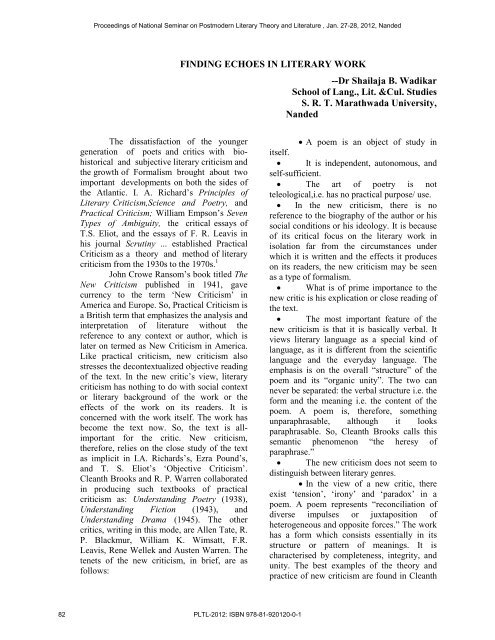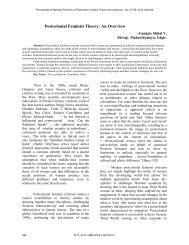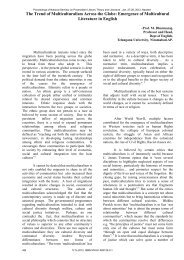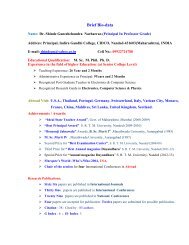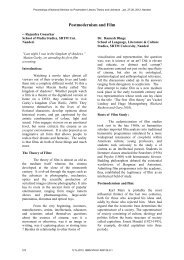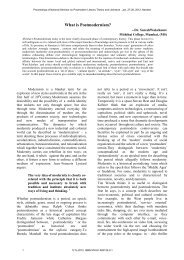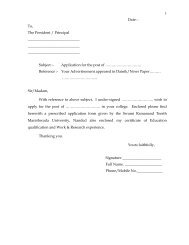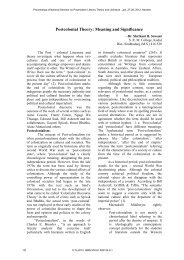Post-Structuralism: An Indian Preview - Igcollege.org
Post-Structuralism: An Indian Preview - Igcollege.org
Post-Structuralism: An Indian Preview - Igcollege.org
You also want an ePaper? Increase the reach of your titles
YUMPU automatically turns print PDFs into web optimized ePapers that Google loves.
Proceedings of National Seminar on <strong>Post</strong>modern Literary Theory and Literature , Jan. 27-28, 2012, Nanded<br />
FINDING ECHOES IN LITERARY WORK<br />
--Dr Shailaja B. Wadikar<br />
School of Lang., Lit. &Cul. Studies<br />
S. R. T. Marathwada University,<br />
Nanded<br />
The dissatisfaction of the younger<br />
generation of poets and critics with biohistorical<br />
and subjective literary criticism and<br />
the growth of Formalism brought about two<br />
important developments on both the sides of<br />
the Atlantic. I. A. Richard’s Principles of<br />
Literary Criticism,Science and Poetry, and<br />
Practical Criticism; William Empson’s Seven<br />
Types of Ambiguity, the critical essays of<br />
T.S. Eliot, and the essays of F. R. Leavis in<br />
his journal Scrutiny ... established Practical<br />
Criticism as a theory and method of literary<br />
criticism from the 1930s to the 1970s. 1<br />
John Crowe Ransom’s book titled The<br />
New Criticism published in 1941, gave<br />
currency to the term ‘New Criticism’ in<br />
America and Europe. So, Practical Criticism is<br />
a British term that emphasizes the analysis and<br />
interpretation of literature without the<br />
reference to any context or author, which is<br />
later on termed as New Criticism in America.<br />
Like practical criticism, new criticism also<br />
stresses the decontextualized objective reading<br />
of the text. In the new critic’s view, literary<br />
criticism has nothing to do with social context<br />
or literary background of the work or the<br />
effects of the work on its readers. It is<br />
concerned with the work itself. The work has<br />
become the text now. So, the text is allimportant<br />
for the critic. New criticism,<br />
therefore, relies on the close study of the text<br />
as implicit in I.A. Richards’s, Ezra Pound’s,<br />
and T. S. Eliot’s ‘Objective Criticism’.<br />
Cleanth Brooks and R. P. Warren collaborated<br />
in producing such textbooks of practical<br />
criticism as: Understanding Poetry (1938),<br />
Understanding Fiction (1943), and<br />
Understanding Drama (1945). The other<br />
critics, writing in this mode, are Allen Tate, R.<br />
P. Blackmur, William K. Wimsatt, F.R.<br />
Leavis, Rene Wellek and Austen Warren. The<br />
tenets of the new criticism, in brief, are as<br />
follows:<br />
• A poem is an object of study in<br />
itself.<br />
• It is independent, autonomous, and<br />
self-sufficient.<br />
• The art of poetry is not<br />
teleological,i.e. has no practical purpose/ use.<br />
• In the new criticism, there is no<br />
reference to the biography of the author or his<br />
social conditions or his ideology. It is because<br />
of its critical focus on the literary work in<br />
isolation far from the circumstances under<br />
which it is written and the effects it produces<br />
on its readers, the new criticism may be seen<br />
as a type of formalism.<br />
• What is of prime importance to the<br />
new critic is his explication or close reading of<br />
the text.<br />
• The most important feature of the<br />
new criticism is that it is basically verbal. It<br />
views literary language as a special kind of<br />
language, as it is different from the scientific<br />
language and the everyday language. The<br />
emphasis is on the overall “structure” of the<br />
poem and its “<strong>org</strong>anic unity”. The two can<br />
never be separated: the verbal structure i.e. the<br />
form and the meaning i.e. the content of the<br />
poem. A poem is, therefore, something<br />
unparaphrasable, although it looks<br />
paraphrasable. So, Cleanth Brooks calls this<br />
semantic phenomenon “the heresy of<br />
paraphrase.”<br />
• The new criticism does not seem to<br />
distinguish between literary genres.<br />
• In the view of a new critic, there<br />
exist ‘tension’, ‘irony’ and ‘paradox’ in a<br />
poem. A poem represents “reconciliation of<br />
diverse impulses or juxtaposition of<br />
heterogeneous and opposite forces.” The work<br />
has a form which consists essentially in its<br />
structure or pattern of meanings. It is<br />
characterised by completeness, integrity, and<br />
unity. The best examples of the theory and<br />
practice of new criticism are found in Cleanth<br />
82 PLTL-2012: ISBN 978-81-920120-0-1


